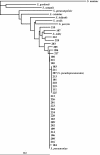Accuracy of phenotypic and genotypic testing for identification of Streptococcus pneumoniae and description of Streptococcus pseudopneumoniae sp. nov
- PMID: 15472328
- PMCID: PMC522306
- DOI: 10.1128/JCM.42.10.4686-4696.2004
Accuracy of phenotypic and genotypic testing for identification of Streptococcus pneumoniae and description of Streptococcus pseudopneumoniae sp. nov
Abstract
We have identified an unusual group of viridans group streptococci that resemble Streptococcus pneumoniae. DNA-DNA homology studies suggested that a subset of these isolates represent a novel species that may be included in the S. oralis-S. mitis group of viridans group streptococci. We suggest that this novel species be termed Streptococcus pseudopneumoniae. A combination of phenotypic and genetic reactions allows its identification. S. pseudopneumoniae strains do not have pneumococcal capsules, are resistant to optochin (inhibition zones, less than 14 mm) when they are incubated under an atmosphere of increased CO2 but are susceptible to optochin (inhibition zones, >14 mm) when they are incubated in ambient atmospheres, are not soluble in bile, and are positive by the GenProbe AccuProbe Pneumococcus test. The bile solubility test is more specific than the optochin test for identification of S. pneumoniae. Genetic tests for pneumolysin (ply) and manganese-dependent superoxide dismutase (sodA) and identification tests with a commercial probe, AccuProbe Pneumococcus, do not discriminate between the new species and S. pneumoniae.
Figures


References
-
- Advisory Committee on Immunization Practices. 1997. Prevention of pneumococcal disease: recommendations of the Advisory Committee on Immunization Practices (ACIP). Morb. Mortal. Wkly. Rep. 46(RR-08):1-24. [Online.] http://www.cdc.gov/epo/mmwr/preview/mmwrhtml/00047135.htm. Accessed March 8, 2003. - PubMed
-
- Baron, E. J., and S. Finegold. 1990. Streptococci and related genera, p. 334-335. In Bailey & Scott's diagnostic microbiology, 8th ed. The C.V. Mosby Company, Toronto, Ontario, Canada.
-
- Borek, A. P., D. C. Dressel, J. Hussong, and L. R. Peterson. 1997. Evolving clinical problems with Streptococcus pneumoniae: increasing resistance to antimicrobial agents, and failure of traditional optochin identification in Chicago, Illinois, between 1993 and 1996. Diagn. Microbiol. Infect. Dis. 29:209-214. - PubMed
Publication types
MeSH terms
Substances
Associated data
- Actions
- Actions
- Actions
LinkOut - more resources
Full Text Sources
Other Literature Sources
Molecular Biology Databases

